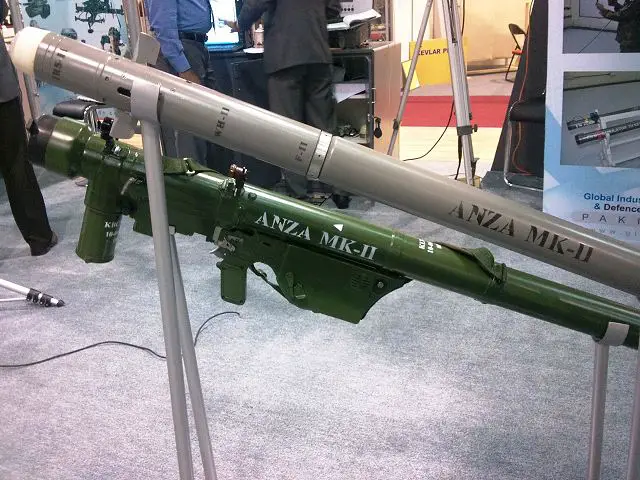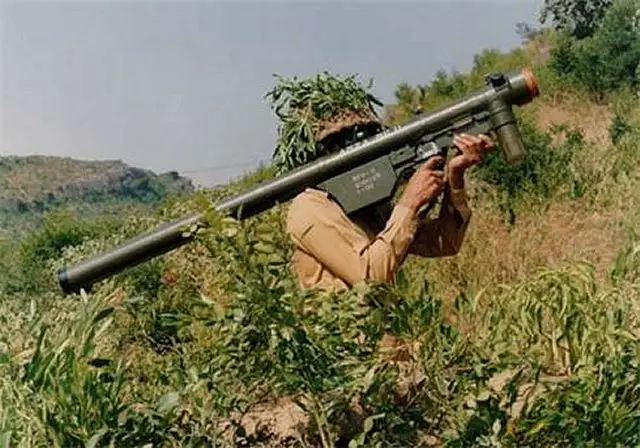- Army
- Air Defense Systems
- Anti-tank systems and vehicles
- Armored Vehicles
- Armoured personnel carriers
- Artillery Vehicles and Weapons
- Command Post
- Communication Vehicles and Systems
- Electronic Warfare
- Engineer | Maintenance Vehicles
- Infantry Fighting Vehicles
- Main Battle Tanks
- Missiles
- Tactical and Logistic Vehicles
- Radars
- Unmanned Systems
- Weapons
- Navy
- Air
Anza Mk-1
| a | |||||||||||||||||||||||||||||||||||||||||||||||||||||||||
|
Anza Mk-I Mk-II Mk-III Man- Portable air defense missile system
|
|||||||||||||||||||||||||||||||||||||||||||||||||||||||||
|
|
|||||||||||||||||||||||||||||||||||||||||||||||||||||||||
|
|
|||||||||||||||||||||||||||||||||||||||||||||||||||||||||
|
a
|
|||||||||||||||||||||||||||||||||||||||||||||||||||||||||
 |
|||||||||||||||||||||||||||||||||||||||||||||||||||||||||
|
The ANZA is a series of man-portable air defense missile system (MANPADS) designed and manufactured at the Institute of Industrial Control Systems, Rawalpindi, Pakistan. The Anza MK-1, Anza MK-2, and Anza MK-3 surface to air anti-aircraft missiles have ranges of 4, 5 and 6 km, respectively. The Anza MKI missiles, which have a range of 4.2 km, were manufactured and handed over to the military forces in 1990. It has been reported that the missile was used during the Kargil incidents between Pakistan and India. Pakistan downed two of India's military planes, a MIG-21 and a MIG-27, with the Anza MKI missiles for violating its airspace on 26 May 1999.
|
|||||||||||||||||||||||||||||||||||||||||||||||||||||||||
| Main Variants | |||||||||||||||||||||||||||||||||||||||||||||||||||||||||
|
- Anza Mk-I: The first MANPADS produced by Pakistan for use by the Pakistan Army. Development is believed to have been assisted by China and the design is similar to the Russian-made SA-7 Grail.
- Anza Mk-II: A third generation MANPADS based on the Chinese QW-1 MANPADS. - Anza Mk-III: Based on the Chinese-made QW-2 MANPADS, modifications made to meet Pakistan Army requirements include a new firing unit similar to the Russian 9K38 Igla MANPADS. |
|||||||||||||||||||||||||||||||||||||||||||||||||||||||||
| Technical Data | |||||||||||||||||||||||||||||||||||||||||||||||||||||||||
| Back to top | |||||||||||||||||||||||||||||||||||||||||||||||||||||||||
|
|||||||||||||||||||||||||||||||||||||||||||||||||||||||||
|
Anza Mk-I
|
|||||||||||||||||||||||||||||||||||||||||||||||||||||||||
 |
|||||||||||||||||||||||||||||||||||||||||||||||||||||||||
|
|
|||||||||||||||||||||||||||||||||||||||||||||||||||||||||
|
Anza Mk-II
|
|||||||||||||||||||||||||||||||||||||||||||||||||||||||||
 |
|||||||||||||||||||||||||||||||||||||||||||||||||||||||||
|
|
|||||||||||||||||||||||||||||||||||||||||||||||||||||||||
|
Anza Mk-III
|
|||||||||||||||||||||||||||||||||||||||||||||||||||||||||
 |
|||||||||||||||||||||||||||||||||||||||||||||||||||||||||
| Back to top | |||||||||||||||||||||||||||||||||||||||||||||||||||||||||
|
Anza Mk-I
|
|||||||||||||||||||||||||||||||||||||||||||||||||||||||||
|
|
|||||||||||||||||||||||||||||||||||||||||||||||||||||||||
|
Anza Mk-II
|
|||||||||||||||||||||||||||||||||||||||||||||||||||||||||
|
|
|||||||||||||||||||||||||||||||||||||||||||||||||||||||||
|
Anza Mk-III
|
|||||||||||||||||||||||||||||||||||||||||||||||||||||||||



























